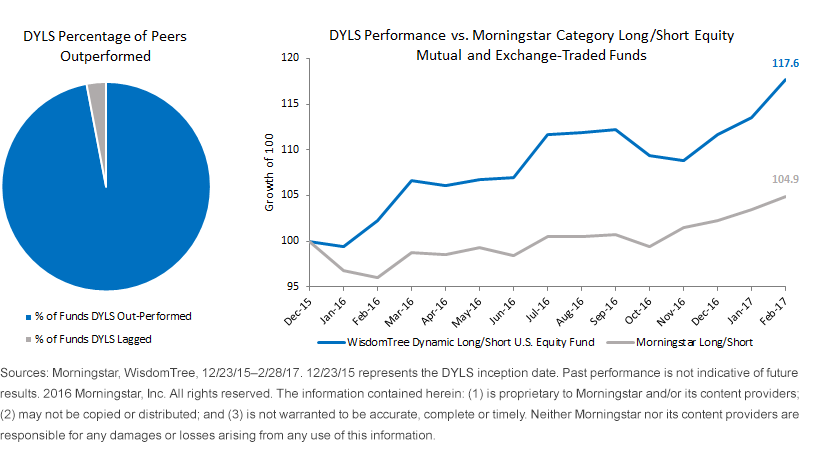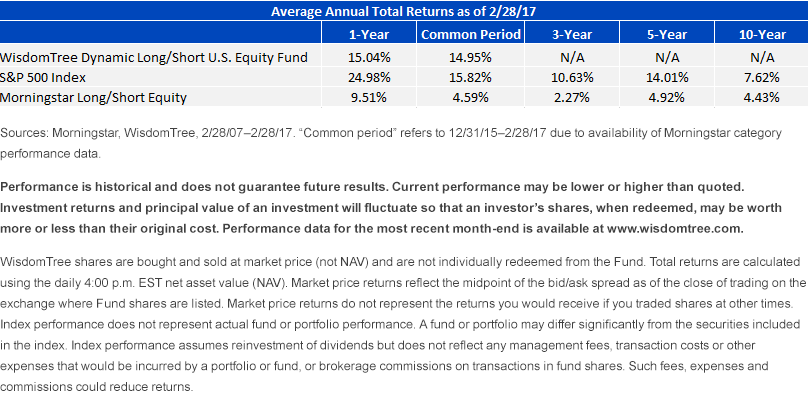How This Long/Short ETF Beat 97% of Its Peers Since Inception


With U.S. markets near all-time highs, and many investors expressing concerns about market valuations, I thought it would be a good time to review the case for the WisdomTree Dynamic Long/Short U.S. Equity Fund (DYLS), a low-cost1, long/short exchange-traded fund (ETF) we developed that may become increasingly relevant for the current market environment.
DYLS, while having gone live only a little over a year ago, has been performing remarkably well, compared to its peer set of long/short funds. DYLS has a portfolio grounded in the academic factor research that is gaining popularity, and the characteristics of the portfolio today are what many investors would find attractive.
These attributes include:
- Quality Tilts: Having higher profitability figures such as return on equity (ROE) and stronger underlying dividend growth trends
- Value Tilts: Having lower price-to-earnings (P/E) ratios and higher dividend yields
- These tilts being done in a sector-neutral fashion, so the portfolio is not just a value strategy or a quality strategy through sector views.
Starting off, these characteristics help understand the selection process. The strategy looks to find less expensive quality stocks in every sector. But it also looks to dynamically hedge market exposure when fundamentals are deteriorating and valuations are high.
Lower-Fee Alternative Strategy
Our main motivation behind this strategy: many of the funds in this category of long/short investments are quite expensive, and we wanted to be among the low-cost leaders in this category. With DYLS among the top five lowest expense ratios, we believe we have achieved this motive.
In a category where funds may charge performance fees and average net expense ratios that are more than three times our expense ratio, that gives us a great head start.

Beating 97% of Peers
DYLS launched in December of 2015, right ahead of a drop in the market in early 2016. Interestingly, our signals on DYLS started off from a hedged standpoint and the Fund launched fully market neutral. Our hedge ratio is adaptive and can range from being fully invested to fully market neutral, and the hedge ratio came off in March. This strong start in the first three months has led the Fund to be ranked #11 of 299 different Morningstar long/short funds based on risk adjusted returns since its inception—and beating 97% of its competition.


Click here for DYLS standardized performance.
Conclusion
DYLS is pretty unique in the ETF structure. Many firms have long/short strategies in hedge fund or mutual fund structures, where they typically charge much higher fees. I believe one of the growth areas for ETFs will be more systematic factor strategies that also look to add short positions in the market to hedge risk. If one can add value both on the long side of the portfolio and then reduce risk on the hedges—which DYLS has done in real time—one has the potential to create one of the best low-cost long/short strategies around. We believe DYLS could interest those looking at lower-volatility alternatives to U.S. market exposure.
1Ordinary brokerage commissions apply.
Important Risks Related to this Article
There are risks associated with investing, including possible loss of principal. The Fund invests in derivatives, including as a substitute to gain short exposure to equity securities. Derivative investments can be volatile, and these investments may be less liquid than other securities, and more sensitive to the effects of varied economic conditions. Derivatives used by the Fund to offset its exposure to market volatility may not perform as intended. The Fund may engage in “short sale” transactions and will lose value if the security or instrument that is the subject of a short sale increases in value. A fund that has exposure to one or more sectors may be more vulnerable to any single economic or regulatory development. This may result in greater share price volatility. The composition of the Index is heavily dependent on quantitative models and data from one or more third parties, and the Index may not perform as intended. The Fund invests in the securities included in, or representative of, its Index regardless of their investment merit, and the Fund does not attempt to outperform its Index or take defensive positions in declining markets. Please read the Fund’s prospectus for specific details regarding the Fund’s risk profile.

Jeremy Schwartz has served as our Global Chief Investment Officer since November 2021 and leads WisdomTree’s investment strategy team in the construction of WisdomTree’s equity Indexes, quantitative active strategies and multi-asset Model Portfolios. Jeremy joined WisdomTree in May 2005 as a Senior Analyst, adding Deputy Director of Research to his responsibilities in February 2007. He served as Director of Research from October 2008 to October 2018 and as Global Head of Research from November 2018 to November 2021. Before joining WisdomTree, he was a head research assistant for Professor Jeremy Siegel and, in 2022, became his co-author on the sixth edition of the book Stocks for the Long Run. Jeremy is also co-author of the Financial Analysts Journal paper “What Happened to the Original Stocks in the S&P 500?” He received his B.S. in economics from The Wharton School of the University of Pennsylvania and hosts the Wharton Business Radio program Behind the Markets on SiriusXM 132. Jeremy is a member of the CFA Society of Philadelphia.

